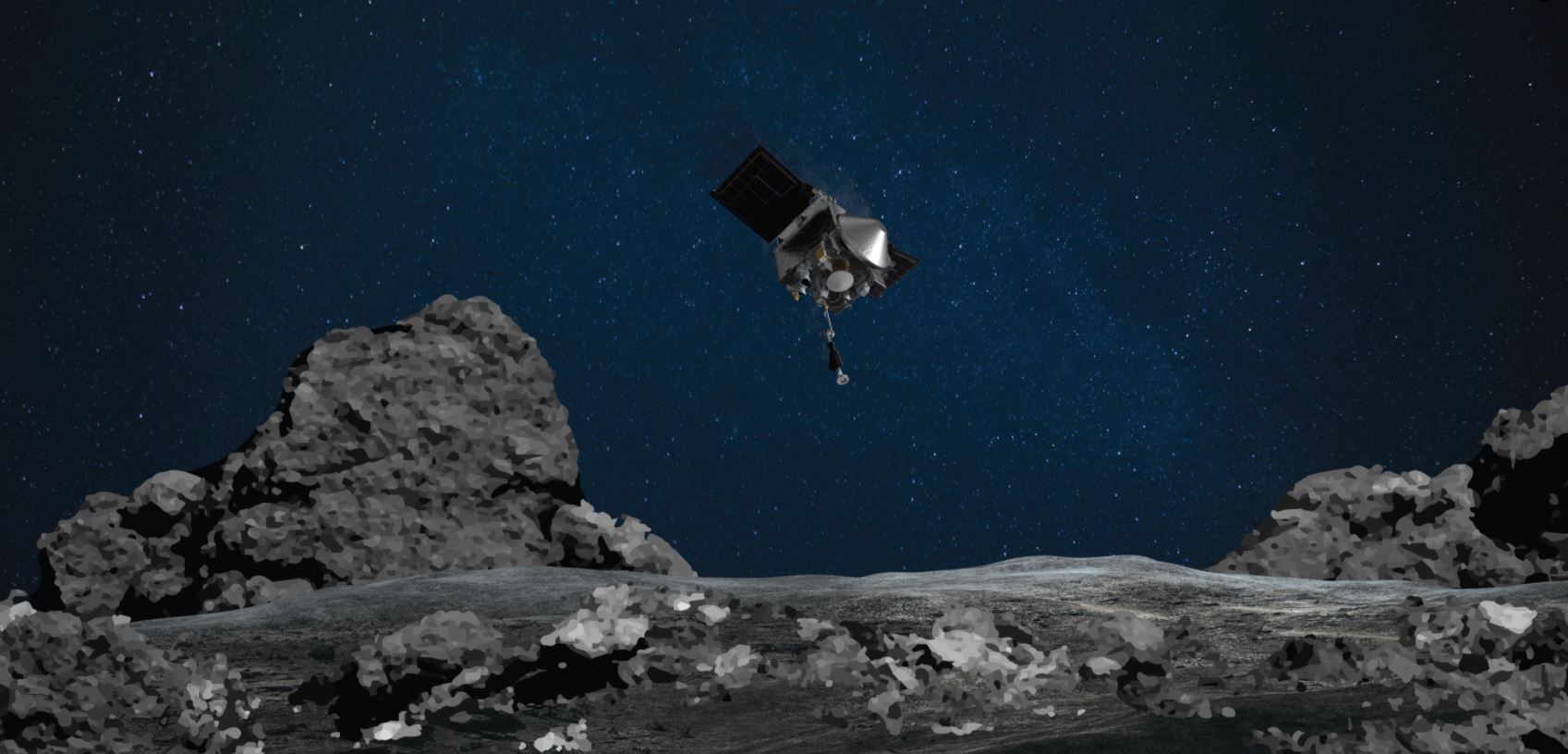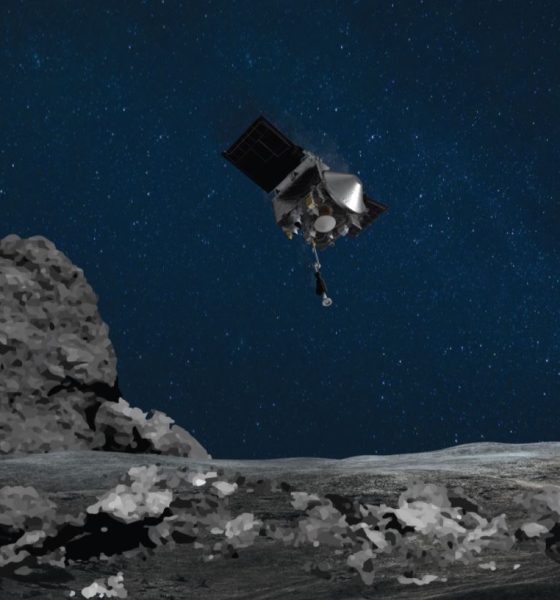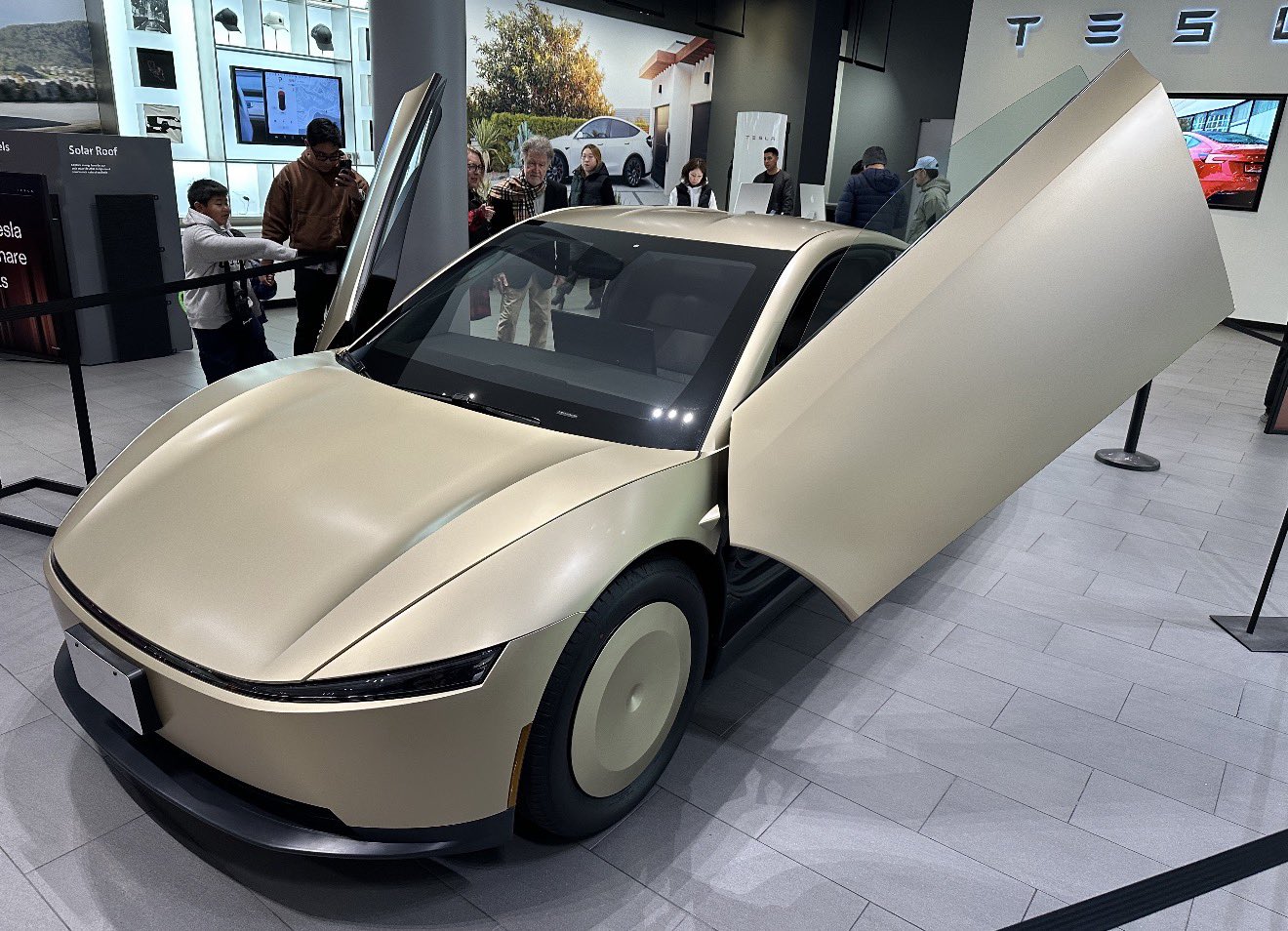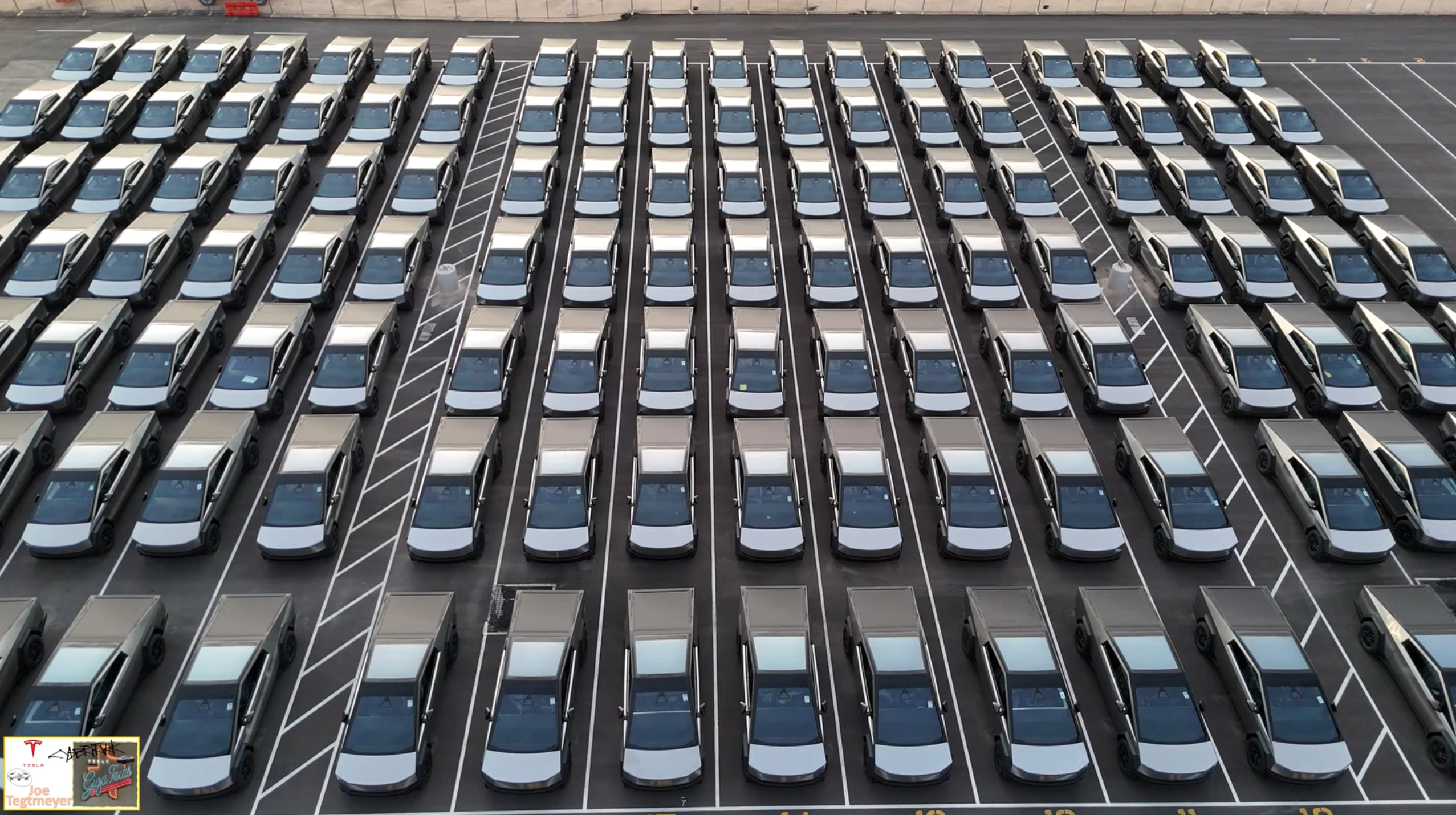

News
NASA prepares to collect asteroid samples next week in deep space OSIRIS-REx mission
NASA currently has an orbiter circling the asteroid Bennu about 200 million miles from Earth, and a live streamed attempt to collect a sample from its surface will be made next week.
The mission, OSIRIS-REx (Origins, Spectral Interpretation, Resource Identification, Security-Regolith Explorer), was developed to help improve our understanding of asteroid impact risks and study how planets and life in the universe began. After a two-year-long journey through deep space, Bennu’s surface has been studied by the orbiter extensively since its arrival in 2018 in preparation for its historic mission. If successful, the craft will land on the asteroid and gather a 2.1 ounce sample that will be returned to our planet in 2023.
“Bennu contains material from the early solar system and may contain the molecular precursors to life and Earth’s oceans,” NASA’s announcement of the live stream detailed. “The asteroid is about as tall as the Empire State Building and could potentially threaten Earth late in the next century, with a 1‐in‐2,700 chance of impacting our planet during one of its close approaches.”
NASA’s live web cast of the event will begin at 6:12 pm EDT on Tuesday, October 20th. Press briefings and other social media activities will be held on October 19th beginning at 1 pm EDT.
All right. Time to get in the zone… On TAG day I need to collect at least 2 oz (60 grams) of Bennu's surface material, but there's a chance I could collect up to 4.4 lbs (2 kg) 😱 guess we'll have to wait and see… it's all part of the journey #ToBennuAndBack pic.twitter.com/c8EgYofjrA
— NASA's OSIRIS-REx (@OSIRISREx) October 14, 2020
OSIRIS-REx, which is about 20 feet long and 10 feet high with its solar panels extended, has a two-part system to collect its asteroid sample. The first, a Touch-And-Go Sample Acquisition Mechanism (TAGSAM), is an articulated robotic arm with a sampler head that extends to the surface to gather regolith. Second, a Sample Return Capsule (SRC), acts as a container with a heat shield and parachutes that will both protect the asteroid regolith and enable reentry into Earth’s atmosphere. The mission is the first of its kind for NASA. Its predecessor is Japan’s Hayabusa mission which returned from with its asteroid sample in 2010.
TAG is six days away. I repeat TAG is SIX days away!
Mark your calendars and join me and my team for the adventure on Oct 20. The live broadcast starts at 5:00 pm EDT and touch down is scheduled for 6:12 pm EDT.
More details and events here: https://t.co/GZmHW4lV2C pic.twitter.com/4aLUPGX4gP
— NASA's OSIRIS-REx (@OSIRISREx) October 14, 2020
NASA has been hard at work over the last decade with its deep space missions. Most recently, the agency’s Insight lander has been making progress studying “Marsquakes” after arriving on Mars in 2018. The newest Mars rover, Perseverance, is en route to the red planet where it will collect a sample of its own from the surface to return to Earth in a future mission. That mission also includes the first rotary craft experiment that will attempt flight on another planet.
Another mission similar to OSIRIS-REx is NASA’s DART (Double Asteroid Redirection Test) spacecraft, scheduled to launch aboard a SpaceX Falcon 9 rocket in July 2021. DART will crash into the asteroid Didymos in 2022, and a European Space Agency orbiter will head to the asteroid in 2023 to study the event’s effects on the space object. Collected data will help formulate planetary defense plans by providing detailed analysis from DART’s real-time asteroid deflection experiment.

News
Wedbush’s Dan Ives sees ‘monster year’ ahead for Tesla amid AI push
In a post on X, the analyst stated that the electric vehicle maker could hit a $3 trillion market cap by the end of 2026 in a bullish scenario.

Wedbush analyst Dan Ives is doubling down on Tesla’s (NASDAQ:TSLA) long-term upside. In a post on X, the analyst stated that the electric vehicle maker could hit a $3 trillion market cap by the end of 2026 in a bullish scenario, thanks to the company’s efforts to develop and push its artificial intelligence programs.
An aggressive valuation upside
Ives, Wedbush’s global head of tech research, stated in his post that Tesla is entering a pivotal period as its autonomy and robotics ambitions move closer to commercialization. He expects Tesla’s market cap to reach $2 trillion in 2026, representing roughly 33% upside from current levels, with a bull case up to a $3 trillion market cap by year-end.
Overall, Ives noted that 2026 could become a “monster year” for TSLA. “Heading into 2026, this marks a monster year ahead for Tesla/Musk as the autonomous and robotics chapter begins. We believe Tesla hits a $2 trillion market cap in 2026 and in a bull case scenario $3 trillion by end of 2026… as the AI chapter takes hold at TSLA,” the analyst wrote.
Ives also reiterated his “Outperform” rating on TSLA stock, as well as his $600 per share price target.
Unsupervised Full-Self Driving tests
Fueling optimism is Tesla’s recent autonomous vehicle testing in Austin, Texas. Over the weekend, at least two Tesla Model Ys were spotted driving on public roads without a safety monitor or any other occupants. CEO Elon Musk later confirmed the footage of one of the vehicles on X, writing in a post that “testing is underway with no occupant in the car.”
It remains unclear whether the vehicle was supported by chase cars or remote monitoring, and Tesla has not disclosed how many vehicles are involved. That being said, Elon Musk stated a week ago that Tesla would be removing its Safety Monitors from its vehicles “within the next three weeks.” Based on the driverless vehicles’ sightings so far, it appears that Musk’s estimate may be right on the mark, at least for now.
News
Production-ready Tesla Cybercab hits showroom floor in San Jose
Tesla has implemented subtle but significant updates to both the Cybercab’s exterior and interior elements.

Tesla has showcased what appears to be a near-production-ready Cybercab at its Santana Row showroom in San Jose, California, giving visitors the closest look yet at the autonomous two-seater’s refined design.
Based on photos of the near-production-ready vehicle, the electric vehicle maker has implemented subtle but significant updates to both the Cybercab’s exterior and interior elements, making the vehicle look more polished and seemingly more comfortable than its prototypes from last year.
Exterior and interior refinements
The updated Cybercab, whose photos were initially shared by Tesla advocate Nic Cruz Patane, now features a new frameless window design, an extended bottom splitter on the front bumper, and a slightly updated rear hatch. It also includes a production-spec front lightbar with integrated headlights, new wheel covers, and a license plate bracket.
Notably, the vehicle now has two windshield wipers instead of the prototype’s single unit, along with powered door struts, seemingly for smoother opening of its butterfly doors. Inside, the Cybercab now sports what appears to be a redesigned dash and door panels, updated carpet material, and slightly refined seat cushions with new center cupholders. Its legroom seems to have gotten slightly larger as well.
Cybercab sightings
Sightings of the updated Cybercab have been abundant in recent months. At the end of October, the Tesla AI team teased some of the autonomous two-seater’s updates after it showed a photo of the vehicle being driven through an In-N-Out drive-through by employees in Halloween costumes. The photos of the Cybercab were fun, but they were significant, with longtime Tesla watchers noting that the company has a tradition of driving its prototypes through the fast food chain’s drive-throughs.
Even at the time, Tesla enthusiasts noticed that the Cybercab had received some design changes, such as segmented DRLs and headlamps, actual turn signals, and a splitter that’s a lot sharper. Larger door openings, which now seem to have been teasing the vehicle’s updated cabin, were also observed at the time.
Investor's Corner
Tesla analyst realizes one big thing about the stock: deliveries are losing importance

Tesla analyst Dan Levy of Barclays realized one big thing about the stock moving into 2026: vehicle deliveries are losing importance.
As a new era of Tesla seems to be on the horizon, the concern about vehicle deliveries and annual growth seems to be fading, at least according to many investors.
Even CEO Elon Musk has implied at times that the automotive side, as a whole, will only make up a small percentage of Tesla’s total valuation, as Optimus and AI begin to shine with importance.
He said in April:
“The future of the company is fundamentally based on large-scale autonomous cars and large-scale and large volume, vast numbers of autonomous humanoid robots.”
Almost all of Tesla’s value long-term will be from AI & robots, both vehicle & humanoid
— Elon Musk (@elonmusk) September 11, 2023
Levy wrote in a note to investors that Tesla’s Q4 delivery figures “likely won’t matter for the stock.” Barclays said in the note that it expects deliveries to be “soft” for the quarter.
In years past, Tesla analysts, investors, and fans were focused on automotive growth.
Cars were truly the biggest thing the stock had to offer: Tesla was a growing automotive company with a lot of prowess in AI and software, but deliveries held the most impact, along with vehicle pricing. These types of things had huge impacts on the stock years ago.
In fact, several large swings occurred because of Tesla either beating or missing delivery estimates:
- January 3, 2022: +13.53%, record deliveries at the time
- January 3, 2023: -12.24%, missed deliveries
- July 2, 2024: +10.20%, beat delivery expectations
- October 3, 2022: -8.61%, sharp miss due to Shanghai factory shutdown
- July 2, 2020: +7.95%, topped low COVID-era expectations with sizeable beat on deliveries
It has become more apparent over the past few quarters that delivery estimates have significantly less focus from investors, who are instead looking for progress in AI, Optimus, Cybercab, and other projects.
These things are the future of the company, and although Tesla will always sell cars, the stock is more impacted by the software the vehicle is running, and not necessarily the vehicle itself.








